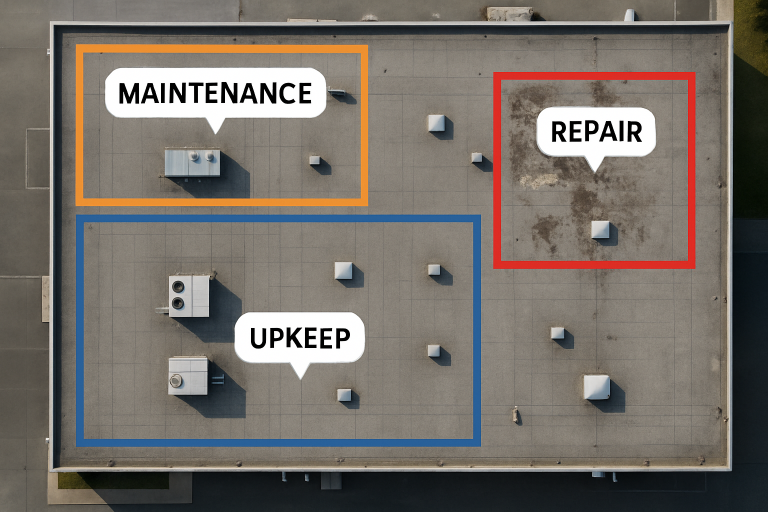What Determines Commercial Roof Lifespan?
Several interwoven factors shape the longevity of a commercial roof. Primary among these are the roof’s material type—such as TPO, EPDM, built-up roofing, or metal—and the quality of its original installation. A professionally installed roof with premium materials will almost always outlast one built to minimal code specifications.
Local climate and environmental exposure play a crucial role. Extreme heat, freeze-thaw cycles, heavy rain, snow loads, and even high winds accelerate wear and tear. Consistent upkeep amplifies durability and can help you avoid premature replacement. As advances in roofing technology continue, modern restoration solutions from companies like SBR Roofing offer comprehensive coatings that make roofs last longer, improving resilience without the need for a costly tear-off.
Ongoing maintenance acts as an insurance policy for your investment. Simple actions—annual inspections, clearing drains, and immediate repairs—can add several years to the roof’s service life. As detailed by the National Roofing Contractors Association, cutting-edge membranes, reflective toppings, and improved fastener technologies all enhance longevity for today’s commercial roofs.
Common Issues Faced by Commercial Roofs
Every roofing system is susceptible to a unique set of challenges. Water intrusion and ponding are the most common and potentially devastating issues. Flat and low-slope roofs, particularly, are vulnerable to standing water, which accelerates membrane breakdown and can compromise roof structure over time.
Membrane tears, seam failures, and edge gaps develop from weekly exposure and thermal movement. Over time, UV rays and dramatic temperature shifts deteriorate surfaces, resulting in brittle, shrunken, or cracked membranes. Addressing these signs early prevents costly repairs down the road.

Signs Your Roof May Need Immediate Attention
Knowing when your commercial roof demands urgent repair is critical. Visible leaks, water stains on interior ceilings, or a mildew smell inside signal that moisture has already breached your system. Blisters, bubbling, or cracks can indicate underlying degradation on the surface.
Another subtle clue is a shift in insulation performance—if rooms beneath the roof feel hotter or colder than usual, the roof may no longer provide adequate protection. Walk the surface and note spongy or soft spots: signs of saturated insulation or possible deck corrosion that need prompt professional assessment.
Benefits of Roof Restoration Over Replacement
Restoration is often the smarter choice over complete replacement when extensive damage isn’t present. Restoration is less expensive and significantly reduces business interruptions. Sustainable roof coatings minimize environmental impact, generating far less landfill waste than a complete tear-off.
Eco-friendliness aside, restoration projects are quicker and offer greater flexibility. Modern restoration methods often renew the roof’s warranty and restore waterproofing in a fraction of the time, creating a seamless, watertight barrier for years to come.
A Brief Guide to Roof Coating Options
Several categories of commercial roof coatings exist, each offering distinct advantages. Elastomeric coatings provide excellent flexibility, making them perfect for roofs that expand and contract with temperature changes. Silicone and acrylic coatings offer superior resistance to ponding water and UV rays.
The choice largely depends on your existing roof type and environmental conditions. Reflective and cool coatings can drop rooftop surface temperatures by dozens of degrees, reducing internal heat transfer and directly slashing energy bills. For a deeper dive into benefits and choosing the right formula for your needs, this Buildings.com resource outlines practical considerations for each type.
Creating a Long-Term Maintenance Schedule
Proactive maintenance is essential for maximizing commercial roof value. Begin with semi-annual inspections, ideally every spring and fall, to evaluate for storm damage or seasonal wear. Follow a detailed checklist: clear drains, check flashings, remove debris, and document all findings.
Address minor repairs—patching small punctures, replacing sealant, tightening fasteners—before they escalate. Keeping thorough maintenance records will help track warranty requirements and assist in future sales or insurance claims. While some tasks are DIY-friendly, having a certified roofing company handle annual inspections and complex repairs is wise to ensure nothing is missed.
How Maintenance Strategies Save Money and Energy
Well-maintained commercial roofs provide a double dividend: lower overhead costs and improved energy efficiency. Clean, intact membranes are less prone to leaks and insulation damage, ensuring that HVAC systems don’t have to work overtime to compensate for lost efficiency.
According to the U.S. Department of Energy, roof coatings with reflective properties can lower peak summer heat transfer by up to 50%. By monitoring energy usage before and after restoration, companies can document savings and justify further long-term maintenance investments.
Frequently Asked Questions
When is it time to restore rather than replace?
Restoration is typically suitable if the underlying deck and insulation are in good condition and the damage is cosmetic primarily or superficial. When in doubt, schedule an inspection with a trusted roofing expert.
How frequently should inspections be scheduled?
Roofs should be inspected at least twice yearly—after winter and summer—and immediately after significant weather events.
Can roof restoration extend warranties?
Yes, many restoration coatings can renew or extend existing manufacturer warranties. To maintain eligibility, be sure to use certified products and installers.
Are there incentives or rebates for cool roofing?
Several states, municipalities, and utility providers offer subsidies for installing energy-efficient, cool roofing solutions. Research local programs or consult with your commercial roofing provider for current options.
Proactive roof maintenance is key to protecting investments and ensuring long-term building performance. By embracing preventive strategies, leveraging modern materials, and utilizing advanced monitoring technologies, businesses can reduce costly repairs and extend roof lifespan. Prioritizing routine inspections and sustainable practices safeguards structures and promotes energy efficiency, safety, and financial stability, equipping organizations to meet future challenges with resilience and confidence.